
Newton, Massachusetts, also known as "The Garden City", boasts a rich horticultural heritage nestled in the heart of New England. With its tree-lined streets, historic charm, and patchwork of parks, Newton is more than ready to embrace seasonal color and ecological gardening. To cultivate year-round beauty in your landscape, it's essential to choose plants suited for USDA Hardiness Zone 6b, capable of withstanding snowy winters, humid summers, and everything in between.
Known for its well-draining loam and slightly acidic soil, Newton offers gardeners fertile ground. With mother nature's seasonal rhythms at play, icy winters, blossoming springs, warm summers, and crisp autumns, it pays to plant with purpose!
Whether you're looking for native stalwarts, ornamental flair, or edible additions, this guide ensures Newton gardeners can nurture vibrant landscapes that blend beauty and biodiversity.
Newton's Climate, Landscape & Soil
Situated along the Charles River in eastern Massachusetts, Newton enjoys a classic New England climate: cold, snowy winters with occasional Nor'easters, and warm, humid summers. The city is built on a rolling, glacially shaped terrain featuring sandy loams and silty soils that are generally well-drained and moderately fertile.
Soil success tips for Newton:
- Amend clay-heavy areas with composted leaf mold or peat moss.
- Topdress with aged manure in spring to enrich the soil organically.
- Use arborist mulch to suppress weeds, regulate moisture, and nurture beneficial fungi.
The state tree of Massachusetts, the American Elm, symbolizes strength and endurance, much like the resilient gardens Newtonians can create.
Top 10 Ornamental Plants For Newton, MA (Zone 6b)
These favorites from Nature Hills Nursery shine through New England's seasons:
-
First Editions® Vanilla Strawberry™ Panicle Hydrangea – Cone-shaped blooms shift from white to rose-pink to deep red.
-
Kwanzan Flowering Cherry – Lavish pink double blooms burst each spring.
-
Blue Chinese Wisteria Tree – Cascading blue-violet blooms in late spring; a garden showstopper.
-
Royal Star Magnolia – Fragrant white blossoms bloom early, sometimes before the last frost.
-
SUNSPARKLER® Wildfire Sedum – A groundcover succulent that adds vivid red foliage.
-
American Beech – Tall, stately, and wildlife-friendly with smooth gray bark and golden autumn leaves.
-
Weeping Willow Tree – Iconic silhouette and fast growth for waterlogged areas.
-
Royal Family Holly Combo – A combo planting of Blue Princess and Blue Princess Holly. Glossy evergreen leaves with vibrant red berries; attracts birds.
-
Santa Rosa Plum Tree – Sweet, juicy plums with lovely spring blossoms in edible landscaping.
- Buttered Popcorn Daylily – Hardy perennial with golden blooms and grassy foliage.
Native Plants For Massachusetts: Make Successful Gardening Easy!
Natives are easy to grow, already adapted to their environment, use less water, are more resistant to pests and diseases in your area, and are in sync with the pollinators and wildlife of your area. And these Massachusetts natives are sure things for your growing zone!
Native Trees of Newton, MA
- Sugar Maple (Acer saccharum) – Known for its blazing fall color and maple syrup production; deeply lobed leaves and dense canopy.
- Northern Red Oak (Quercus rubra) – Tall, spreading crown with lobed leaves; provides acorns for wildlife.
- Eastern/Canadian Hemlock (Tsuga canadensis) – Graceful evergreen native to cool woodland slopes; delicate needles and small cones.
- Eastern White Pine (Pinus strobus) – Massachusetts' former state tree; soft, fragrant needles in bundles of five.
Native Shrubs For Structure & Color
- Witch Hazel (Hamamelis virginiana) – Fall-blooming with spidery yellow flowers; bark used medicinally by Native Americans.
- Lowbush Blueberry (Vaccinium angustifolium) – Edible berries, fiery fall color, and compact growth.
- Sweet Pepperbush (Clethra alnifolia) – Also known as Summersweet, these summer-blooming shrubs have fragrant white flowers; great for pollinators.
- Northern Bayberry (Myrica pensylvanica) – Waxy gray berries once used for candle-making; aromatic foliage.
Native Perennials That Endure
- New England Aster (Symphyotrichum novae-angliae) – Late-summer purple blooms; a monarch butterfly magnet.
- Columbine (Aquilegia canadensis) – Delicate red and yellow flowers with nodding spurs; attracts hummingbirds.
- Wild Bergamot (Monarda fistulosa) – Also known as Bee Balm, lavender-pink blooms with a minty scent; beloved by bees.
- Solomon's Seal (Polygonatum biflorum) – Graceful arching stems with bell-shaped flowers beneath.
Native Fruiting Trees
- American Plum (Prunus americana) – White spring flowers and tart red fruit; supports local pollinators.
- Serviceberry (Amelanchier canadensis) – Also known as Shadbush; edible berries and white spring blooms.
Native Fruiting Bushes & Vines
-
Elderberry (Sambucus canadensis) – Clusters of dark berries for jams and syrups; also a wildlife haven.
Concord Grapes (Vitis 'Concord') – Native fruiting vines that grow vigorously and fruit reliably in Newton's summers.
From The Charles River To Crystal Lake: Plant With Purpose

With its leafy neighborhoods, historic village centers, and proximity to the Charles River and Crystal Lake, Newton offers a picturesque backdrop for a garden that reflects the soul of New England.
Imagine strolling through your own backyard in late spring, greeted by the scent of blooming Royal Star Magnolia while Bluebirds flutter among Serviceberry trees, just like a morning at Cold Spring Park or the trails of Hemlock Gorge!
Planting with care in Newton is more than just a hobby; it's a way to honor the region's heritage, support native wildlife, and mirror the natural beauty found throughout this historic city. Whether you're in West Newton or Newton Highlands, let your garden echo the charm of the neighborhood, the rhythm of the seasons, and the wild grace of mother nature herself!
Happy Planting!

